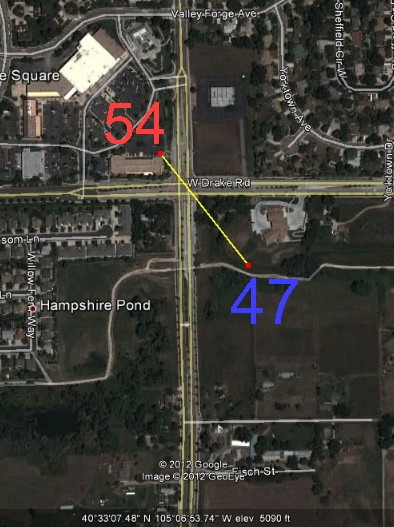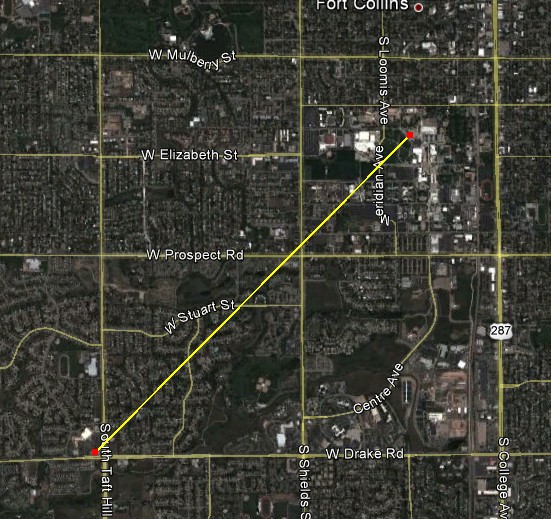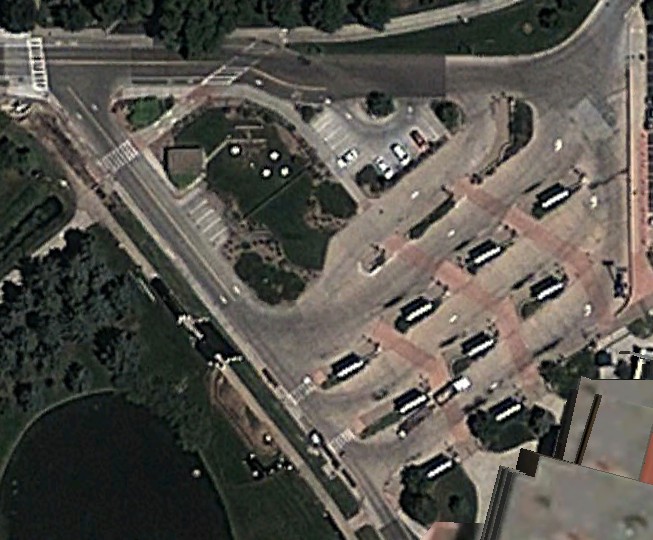I ride my bike everywhere, and normally in shorts and a T-shirt – so I notice changes in temperature. One thing that has become abundantly obvious is that temperatures near asphalt are much higher than in open space.
I just did an experiment in Fort Collins, Colorado at 1:30am. It is a full moon and the air is dead calm. I took a bike ride with a thermometer, which I have permanently affixed to the bike. It turns out that temperatures are 7F cooler in the open space region below, less than 0.2 miles away from the parking lot of a shopping center.
As soon as I rode away from the intersection, temperatures felt much cooler. This was not an isolated incident – I feel it consistently on clear, calm nights.
Hansen’s assumptions about heat islands are based on population, but I believe that the bulk of the effect occurs when a single asphalt road is put in place. Much of the claimed warming during the 20th century was likely due to the appearance of asphalt roads in rural regions.
Muller’s claims about UHI are similarly flawed, as they are based on population. Comparing large cities vs. small towns is largely meaningless, because all it takes is one asphalt road to produce significant warming.
Over on the CSU campus 2.3 miles away, temperatures were much warmer – 57.8 degrees at the official Fort Collins weather station. This station has not moved for 140 years, and shows a lot of warming during that time. It is now located in the middle of a bus parking lot.





Steve,
Have you got your grant papers ready to apply to the EPA for the full study?
Just tell them that you are researching an anomaly in City Warming Effects that are under-rating warming effects in the city.
Less Trees = More heat
The cooler open areas are treeless. There are more trees in the warm parking lot.
In Ohio, temperature trends since 1940 show that some stations have warmed by more than 2F compared to others. The variation is not just an odd station, but spread across all 26 USHCN sites. Most are rural or small towns.
A similar exercise in Kansas showed the same.
It is inconceivable that such variation can be caused by climatic factors. Therefore it can only be due to localised non climatic issues.
http://notalotofpeopleknowthat.wordpress.com/2012/04/09/ohio-temperature-trends/
I drove thru a park on a hot day and my car thermometer dropped 10 degrees, then rebounded 10 degrees once I left the park. Local effects can make a big difference.
I created a fat caricature of Al Gore out of Charcoal Briquettes and set them afire. It was much warmer around the barbeque than it was in the fridge where I got my beer. Conclusion: Al Gore puts out a lot of hot gas, and Full Sail Amber Ale is the best beer in America.
Depending on the time of day, trees have different effects on the micro climate where they are. During the day, when trees are in full leaf, they will cool, if the temperature gets warmer than what the trees wants. However, on a cold day with the sun shining, being in a forest, or any location populated by many trees it will be warmer than the surrounding area that lacks trees.
There are too many variables, to make any one claim regarding vegetation and temperatures.
I have ridden bicycles and walked through a variety of landscapes. I did not require a thermometer to recognized the changes.
What you say is true for the circumstances you describe, however it does not describe all situations. There are many variables that will give different reading in the same microclimates that you were measuring.
I have known this for decades. I used to play alot of late night frisbee, and mall parking lots were great for long distance throwing. We would grab some beer, head out and spend hours hurling a disc around. When we would break and walk off the asphalt, you could immediately feel the air cool.
Funny now to think that this happened while I was a climatology student, and forever changed the way I look at cities.Often the best the learning experiences happens outside the classroom, and sometimes over a beer. 😉
It’s the Water!
Or was that:
This One’s For You! 😉
Hey Mike! I was passing through Nashville the same day you and James had your rendezvous. Maybe next time…
Maybe I will have to look you up during on of my next rides.
James can give you a way to contact me, Well let me rephrase that you can contact me, not ME! 😉
Gator:
That would have been quite something.
😆